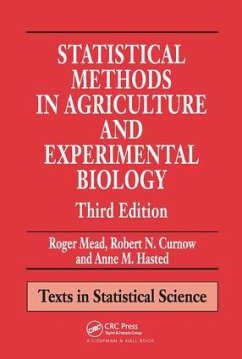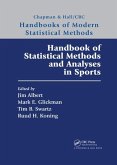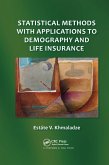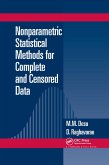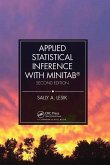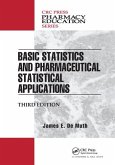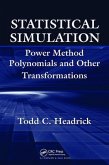Roger Mead
Statistical Methods in Agriculture and Experimental Biology
Roger Mead
Statistical Methods in Agriculture and Experimental Biology
- Broschiertes Buch
- Merkliste
- Auf die Merkliste
- Bewerten Bewerten
- Teilen
- Produkt teilen
- Produkterinnerung
- Produkterinnerung
The third edition of this popular introductory text maintains the character that won worldwide respect for its predecessors but features a number of enhancements that broaden its scope, increase its utility, and bring the treatment thoroughly up to date. It provides complete coverage of the statistical ideas and methods essential to students in agriculture or experimental biology. In addition to covering fundamental methodology, this treatment also includes more advanced topics that the authors believe help develop an appreciation of the breadth of statistical methodology now available. The…mehr
Andere Kunden interessierten sich auch für
![Handbook of Statistical Methods and Analyses in Sports Handbook of Statistical Methods and Analyses in Sports]() Handbook of Statistical Methods and Analyses in Sports92,99 €
Handbook of Statistical Methods and Analyses in Sports92,99 €![Statistical Methods with Applications to Demography and Life Insurance Statistical Methods with Applications to Demography and Life Insurance]() Estáte V. KhmaladzeStatistical Methods with Applications to Demography and Life Insurance94,99 €
Estáte V. KhmaladzeStatistical Methods with Applications to Demography and Life Insurance94,99 €![Nonparametric Statistical Methods For Complete and Censored Data Nonparametric Statistical Methods For Complete and Censored Data]() M. M. DesuNonparametric Statistical Methods For Complete and Censored Data94,99 €
M. M. DesuNonparametric Statistical Methods For Complete and Censored Data94,99 €![Applied Statistical Inference with MINITAB®, Second Edition Applied Statistical Inference with MINITAB®, Second Edition]() Sally A. LesikApplied Statistical Inference with MINITAB®, Second Edition69,99 €
Sally A. LesikApplied Statistical Inference with MINITAB®, Second Edition69,99 €![Basic Statistics and Pharmaceutical Statistical Applications Basic Statistics and Pharmaceutical Statistical Applications]() James E. De MuthBasic Statistics and Pharmaceutical Statistical Applications74,99 €
James E. De MuthBasic Statistics and Pharmaceutical Statistical Applications74,99 €![Statistical Simulation Statistical Simulation]() Todd C. HeadrickStatistical Simulation101,99 €
Todd C. HeadrickStatistical Simulation101,99 €![Statistical Approaches in Oncology Clinical Development Statistical Approaches in Oncology Clinical Development]() Statistical Approaches in Oncology Clinical Development80,99 €
Statistical Approaches in Oncology Clinical Development80,99 €-
-
-
The third edition of this popular introductory text maintains the character that won worldwide respect for its predecessors but features a number of enhancements that broaden its scope, increase its utility, and bring the treatment thoroughly up to date. It provides complete coverage of the statistical ideas and methods essential to students in agriculture or experimental biology. In addition to covering fundamental methodology, this treatment also includes more advanced topics that the authors believe help develop an appreciation of the breadth of statistical methodology now available. The emphasis is not on mathematical detail, but on ensuring students understand why and when various methods should be used. New in the Third Edition: A chapter on the two simplest yet most important methods of multivariate analysis Increased emphasis on modern computer applications Discussions on a wider range of data types and the graphical display of data Analysis of mixed cropping experiments and on-farm experiments
Hinweis: Dieser Artikel kann nur an eine deutsche Lieferadresse ausgeliefert werden.
Hinweis: Dieser Artikel kann nur an eine deutsche Lieferadresse ausgeliefert werden.
Produktdetails
- Produktdetails
- Verlag: Chapman and Hall/CRC
- 3. Auflage
- Seitenzahl: 490
- Erscheinungstermin: 28. August 2002
- Englisch
- Abmessung: 234mm x 156mm x 26mm
- Gewicht: 737g
- ISBN-13: 9781584881872
- ISBN-10: 1584881879
- Artikelnr.: 21884864
- Herstellerkennzeichnung
- Libri GmbH
- Europaallee 1
- 36244 Bad Hersfeld
- gpsr@libri.de
- Verlag: Chapman and Hall/CRC
- 3. Auflage
- Seitenzahl: 490
- Erscheinungstermin: 28. August 2002
- Englisch
- Abmessung: 234mm x 156mm x 26mm
- Gewicht: 737g
- ISBN-13: 9781584881872
- ISBN-10: 1584881879
- Artikelnr.: 21884864
- Herstellerkennzeichnung
- Libri GmbH
- Europaallee 1
- 36244 Bad Hersfeld
- gpsr@libri.de
Roger Mead
INTRODUCTION
The Need for Statistics
Types of Data
The Use of Computers in Statistics
PROBABILITY AND DISTRIBUTIONS
Probability
Populations and Samples
Means and Variances
The Normal Distribution
Sampling Distributions
ESTIMATION AND HYPOTHESIS TESTING
Estimation of the Population Mean
Testing Hypotheses about the Population Mean
Population Variance Unknown
Comparison of Samples
A Pooled Estimate of Variance
A SIMPLE EXPERIMENT
Randomization and Replication
Analysis of a Completely Randomized Design with Two Treatments
A Completely Randomized Design with Several Treatments
Testing Overall Variation Between the Treatments
CONTROL OF RANDOM VARIATION BY BLOCKING
Local Control of Variation
Analysis of a Randomized Block Design
Meaning of the Error Mean Square
Latin Square Designs
Multiple Latin Squares Design
The Benefit of Blocking and the Use of Natural Blocks
PARTICULAR QUESTIONS ABOUT TREATMENTS
Treatment Structure
Treatment Contrasts
Factorial Treatment Structure
Main Effects and Interactions
Analysis of Variance for a Two-Factor Experiment
Partial Factorial Structure
Comparing Treatment Means - Are Multiple Comparison Methods Helpful?
MORE ON FACTORIAL TREATMENT STRUCTURE
More than Two Factors
Factors with Two Levels
The Double Benefit of Factorial Structure
Many Factors and Small Blocks
The Analysis of Confounded Experiments
Split Plot Experiments
Analysis of a Split Plot Experiment
Experiments Repeated at Different Sites
THE ASSUMPTIONS BEHIND THE ANALYSIS
Our Assumptions
Normality
Variance Homogeneity
Additivity
Transformations of Data for Theoretical Reasons
A More General Form of Analysis
Empirical Detection of the Failure of Assumptions and Selection of
Appropriate Transformations
Practice and Presentation
STUDYING LINEAR RELATIONSHIPS
Linear Regression
Assessing the Regression Line
Inferences about the Slope of a Line
Prediction Using a Regression Line
Correlation
Testing Whether the Regression is Linear
Regression Analysis Using Computer Packages
MORE COMPLEX RELATIONSHIPS
Making the Crooked Straight
Two Independent Variables
Testing the Components of a Multiple Relationship
Multiple Regression
Possible Problems in Computer Multiple Regression
LINEAR MODELS
The Use of Models
Models for Factors and Variables
Comparison of Regressions
Fitting Parallel Lines
Covariance Analysis
Regression in the Analysis of Treatment Variation
NONLINEAR MODELS
Advantages of Linear and Nonlinear Models
Fitting Nonlinear Models to Data
Inferences about Nonlinear Parameters
Exponential Models
Inverse Polynomial Models
Logistic Models for Growth Curves
THE ANALYSIS OF PROPORTIONS
Data in the Form of Frequencies
The 2 ¿ 2 Contingency Table
More than Two Situations or More than Two Outcomes
General Contingency Tables
Estimation of Proportions
Sample Sizes for Estimating Proportions
MODELS AND DISTRIBUTIONS FOR FREQUENCY DATA
Models for Frequency Data
Testing the Agreement of Frequency Data with Simple Models
Investigating More Complex Models
The Binomial Distribution
The Poisson Distribution
Generalized Models for Analyzing Experimental Data
Log-Linear Models
Logit Analysis of Response Data
MAKING AND ANALYZING SEVERAL EXPERIMENTAL MEASUREMENTS
Different Measurements on the Same Units
Interdependence of Different Variables
Repeated Measurements
Joint (Bivariate) Analysis
Indices of Combined Yield
Investigating Relationships with Experimental Data
ANALYZING AND SUMMARIZING MANY MEASUREMENTS
Introduction to Multivariate Data
Principal Component Analysis
Covariance or Correlation Matrix
Cluster Analysis
Similarity and Dissimilarity Measures
Hierarchical Clustering
Comparison of PCA and Cluster Analysis
CHOOSING THE MOST APPROPRIATE EXPERIMENTAL DESIGN
The Components of Design; Units and Treatments
Replication and Precision
Different Levels of Variation and Within-Unit Replication
Variance Components and Split Plot Designs
Randomization
Managing with Limited Resources
Factors with Quantitative Levels
Screening and Selection
On-Farm Experiments
SAMPLING FINITE POPULATIONS
Experiments and Sample Surveys
Simple Random Sampling
Stratified Random Sampling
Cluster Sampling, Multistage Sampling and
Sampling Proportional to Size
Ratio and Regression Estimates
REFERENCES
APPENDIX
INDEX
The Need for Statistics
Types of Data
The Use of Computers in Statistics
PROBABILITY AND DISTRIBUTIONS
Probability
Populations and Samples
Means and Variances
The Normal Distribution
Sampling Distributions
ESTIMATION AND HYPOTHESIS TESTING
Estimation of the Population Mean
Testing Hypotheses about the Population Mean
Population Variance Unknown
Comparison of Samples
A Pooled Estimate of Variance
A SIMPLE EXPERIMENT
Randomization and Replication
Analysis of a Completely Randomized Design with Two Treatments
A Completely Randomized Design with Several Treatments
Testing Overall Variation Between the Treatments
CONTROL OF RANDOM VARIATION BY BLOCKING
Local Control of Variation
Analysis of a Randomized Block Design
Meaning of the Error Mean Square
Latin Square Designs
Multiple Latin Squares Design
The Benefit of Blocking and the Use of Natural Blocks
PARTICULAR QUESTIONS ABOUT TREATMENTS
Treatment Structure
Treatment Contrasts
Factorial Treatment Structure
Main Effects and Interactions
Analysis of Variance for a Two-Factor Experiment
Partial Factorial Structure
Comparing Treatment Means - Are Multiple Comparison Methods Helpful?
MORE ON FACTORIAL TREATMENT STRUCTURE
More than Two Factors
Factors with Two Levels
The Double Benefit of Factorial Structure
Many Factors and Small Blocks
The Analysis of Confounded Experiments
Split Plot Experiments
Analysis of a Split Plot Experiment
Experiments Repeated at Different Sites
THE ASSUMPTIONS BEHIND THE ANALYSIS
Our Assumptions
Normality
Variance Homogeneity
Additivity
Transformations of Data for Theoretical Reasons
A More General Form of Analysis
Empirical Detection of the Failure of Assumptions and Selection of
Appropriate Transformations
Practice and Presentation
STUDYING LINEAR RELATIONSHIPS
Linear Regression
Assessing the Regression Line
Inferences about the Slope of a Line
Prediction Using a Regression Line
Correlation
Testing Whether the Regression is Linear
Regression Analysis Using Computer Packages
MORE COMPLEX RELATIONSHIPS
Making the Crooked Straight
Two Independent Variables
Testing the Components of a Multiple Relationship
Multiple Regression
Possible Problems in Computer Multiple Regression
LINEAR MODELS
The Use of Models
Models for Factors and Variables
Comparison of Regressions
Fitting Parallel Lines
Covariance Analysis
Regression in the Analysis of Treatment Variation
NONLINEAR MODELS
Advantages of Linear and Nonlinear Models
Fitting Nonlinear Models to Data
Inferences about Nonlinear Parameters
Exponential Models
Inverse Polynomial Models
Logistic Models for Growth Curves
THE ANALYSIS OF PROPORTIONS
Data in the Form of Frequencies
The 2 ¿ 2 Contingency Table
More than Two Situations or More than Two Outcomes
General Contingency Tables
Estimation of Proportions
Sample Sizes for Estimating Proportions
MODELS AND DISTRIBUTIONS FOR FREQUENCY DATA
Models for Frequency Data
Testing the Agreement of Frequency Data with Simple Models
Investigating More Complex Models
The Binomial Distribution
The Poisson Distribution
Generalized Models for Analyzing Experimental Data
Log-Linear Models
Logit Analysis of Response Data
MAKING AND ANALYZING SEVERAL EXPERIMENTAL MEASUREMENTS
Different Measurements on the Same Units
Interdependence of Different Variables
Repeated Measurements
Joint (Bivariate) Analysis
Indices of Combined Yield
Investigating Relationships with Experimental Data
ANALYZING AND SUMMARIZING MANY MEASUREMENTS
Introduction to Multivariate Data
Principal Component Analysis
Covariance or Correlation Matrix
Cluster Analysis
Similarity and Dissimilarity Measures
Hierarchical Clustering
Comparison of PCA and Cluster Analysis
CHOOSING THE MOST APPROPRIATE EXPERIMENTAL DESIGN
The Components of Design; Units and Treatments
Replication and Precision
Different Levels of Variation and Within-Unit Replication
Variance Components and Split Plot Designs
Randomization
Managing with Limited Resources
Factors with Quantitative Levels
Screening and Selection
On-Farm Experiments
SAMPLING FINITE POPULATIONS
Experiments and Sample Surveys
Simple Random Sampling
Stratified Random Sampling
Cluster Sampling, Multistage Sampling and
Sampling Proportional to Size
Ratio and Regression Estimates
REFERENCES
APPENDIX
INDEX
INTRODUCTION
The Need for Statistics
Types of Data
The Use of Computers in Statistics
PROBABILITY AND DISTRIBUTIONS
Probability
Populations and Samples
Means and Variances
The Normal Distribution
Sampling Distributions
ESTIMATION AND HYPOTHESIS TESTING
Estimation of the Population Mean
Testing Hypotheses about the Population Mean
Population Variance Unknown
Comparison of Samples
A Pooled Estimate of Variance
A SIMPLE EXPERIMENT
Randomization and Replication
Analysis of a Completely Randomized Design with Two Treatments
A Completely Randomized Design with Several Treatments
Testing Overall Variation Between the Treatments
CONTROL OF RANDOM VARIATION BY BLOCKING
Local Control of Variation
Analysis of a Randomized Block Design
Meaning of the Error Mean Square
Latin Square Designs
Multiple Latin Squares Design
The Benefit of Blocking and the Use of Natural Blocks
PARTICULAR QUESTIONS ABOUT TREATMENTS
Treatment Structure
Treatment Contrasts
Factorial Treatment Structure
Main Effects and Interactions
Analysis of Variance for a Two-Factor Experiment
Partial Factorial Structure
Comparing Treatment Means - Are Multiple Comparison Methods Helpful?
MORE ON FACTORIAL TREATMENT STRUCTURE
More than Two Factors
Factors with Two Levels
The Double Benefit of Factorial Structure
Many Factors and Small Blocks
The Analysis of Confounded Experiments
Split Plot Experiments
Analysis of a Split Plot Experiment
Experiments Repeated at Different Sites
THE ASSUMPTIONS BEHIND THE ANALYSIS
Our Assumptions
Normality
Variance Homogeneity
Additivity
Transformations of Data for Theoretical Reasons
A More General Form of Analysis
Empirical Detection of the Failure of Assumptions and Selection of
Appropriate Transformations
Practice and Presentation
STUDYING LINEAR RELATIONSHIPS
Linear Regression
Assessing the Regression Line
Inferences about the Slope of a Line
Prediction Using a Regression Line
Correlation
Testing Whether the Regression is Linear
Regression Analysis Using Computer Packages
MORE COMPLEX RELATIONSHIPS
Making the Crooked Straight
Two Independent Variables
Testing the Components of a Multiple Relationship
Multiple Regression
Possible Problems in Computer Multiple Regression
LINEAR MODELS
The Use of Models
Models for Factors and Variables
Comparison of Regressions
Fitting Parallel Lines
Covariance Analysis
Regression in the Analysis of Treatment Variation
NONLINEAR MODELS
Advantages of Linear and Nonlinear Models
Fitting Nonlinear Models to Data
Inferences about Nonlinear Parameters
Exponential Models
Inverse Polynomial Models
Logistic Models for Growth Curves
THE ANALYSIS OF PROPORTIONS
Data in the Form of Frequencies
The 2 ¿ 2 Contingency Table
More than Two Situations or More than Two Outcomes
General Contingency Tables
Estimation of Proportions
Sample Sizes for Estimating Proportions
MODELS AND DISTRIBUTIONS FOR FREQUENCY DATA
Models for Frequency Data
Testing the Agreement of Frequency Data with Simple Models
Investigating More Complex Models
The Binomial Distribution
The Poisson Distribution
Generalized Models for Analyzing Experimental Data
Log-Linear Models
Logit Analysis of Response Data
MAKING AND ANALYZING SEVERAL EXPERIMENTAL MEASUREMENTS
Different Measurements on the Same Units
Interdependence of Different Variables
Repeated Measurements
Joint (Bivariate) Analysis
Indices of Combined Yield
Investigating Relationships with Experimental Data
ANALYZING AND SUMMARIZING MANY MEASUREMENTS
Introduction to Multivariate Data
Principal Component Analysis
Covariance or Correlation Matrix
Cluster Analysis
Similarity and Dissimilarity Measures
Hierarchical Clustering
Comparison of PCA and Cluster Analysis
CHOOSING THE MOST APPROPRIATE EXPERIMENTAL DESIGN
The Components of Design; Units and Treatments
Replication and Precision
Different Levels of Variation and Within-Unit Replication
Variance Components and Split Plot Designs
Randomization
Managing with Limited Resources
Factors with Quantitative Levels
Screening and Selection
On-Farm Experiments
SAMPLING FINITE POPULATIONS
Experiments and Sample Surveys
Simple Random Sampling
Stratified Random Sampling
Cluster Sampling, Multistage Sampling and
Sampling Proportional to Size
Ratio and Regression Estimates
REFERENCES
APPENDIX
INDEX
The Need for Statistics
Types of Data
The Use of Computers in Statistics
PROBABILITY AND DISTRIBUTIONS
Probability
Populations and Samples
Means and Variances
The Normal Distribution
Sampling Distributions
ESTIMATION AND HYPOTHESIS TESTING
Estimation of the Population Mean
Testing Hypotheses about the Population Mean
Population Variance Unknown
Comparison of Samples
A Pooled Estimate of Variance
A SIMPLE EXPERIMENT
Randomization and Replication
Analysis of a Completely Randomized Design with Two Treatments
A Completely Randomized Design with Several Treatments
Testing Overall Variation Between the Treatments
CONTROL OF RANDOM VARIATION BY BLOCKING
Local Control of Variation
Analysis of a Randomized Block Design
Meaning of the Error Mean Square
Latin Square Designs
Multiple Latin Squares Design
The Benefit of Blocking and the Use of Natural Blocks
PARTICULAR QUESTIONS ABOUT TREATMENTS
Treatment Structure
Treatment Contrasts
Factorial Treatment Structure
Main Effects and Interactions
Analysis of Variance for a Two-Factor Experiment
Partial Factorial Structure
Comparing Treatment Means - Are Multiple Comparison Methods Helpful?
MORE ON FACTORIAL TREATMENT STRUCTURE
More than Two Factors
Factors with Two Levels
The Double Benefit of Factorial Structure
Many Factors and Small Blocks
The Analysis of Confounded Experiments
Split Plot Experiments
Analysis of a Split Plot Experiment
Experiments Repeated at Different Sites
THE ASSUMPTIONS BEHIND THE ANALYSIS
Our Assumptions
Normality
Variance Homogeneity
Additivity
Transformations of Data for Theoretical Reasons
A More General Form of Analysis
Empirical Detection of the Failure of Assumptions and Selection of
Appropriate Transformations
Practice and Presentation
STUDYING LINEAR RELATIONSHIPS
Linear Regression
Assessing the Regression Line
Inferences about the Slope of a Line
Prediction Using a Regression Line
Correlation
Testing Whether the Regression is Linear
Regression Analysis Using Computer Packages
MORE COMPLEX RELATIONSHIPS
Making the Crooked Straight
Two Independent Variables
Testing the Components of a Multiple Relationship
Multiple Regression
Possible Problems in Computer Multiple Regression
LINEAR MODELS
The Use of Models
Models for Factors and Variables
Comparison of Regressions
Fitting Parallel Lines
Covariance Analysis
Regression in the Analysis of Treatment Variation
NONLINEAR MODELS
Advantages of Linear and Nonlinear Models
Fitting Nonlinear Models to Data
Inferences about Nonlinear Parameters
Exponential Models
Inverse Polynomial Models
Logistic Models for Growth Curves
THE ANALYSIS OF PROPORTIONS
Data in the Form of Frequencies
The 2 ¿ 2 Contingency Table
More than Two Situations or More than Two Outcomes
General Contingency Tables
Estimation of Proportions
Sample Sizes for Estimating Proportions
MODELS AND DISTRIBUTIONS FOR FREQUENCY DATA
Models for Frequency Data
Testing the Agreement of Frequency Data with Simple Models
Investigating More Complex Models
The Binomial Distribution
The Poisson Distribution
Generalized Models for Analyzing Experimental Data
Log-Linear Models
Logit Analysis of Response Data
MAKING AND ANALYZING SEVERAL EXPERIMENTAL MEASUREMENTS
Different Measurements on the Same Units
Interdependence of Different Variables
Repeated Measurements
Joint (Bivariate) Analysis
Indices of Combined Yield
Investigating Relationships with Experimental Data
ANALYZING AND SUMMARIZING MANY MEASUREMENTS
Introduction to Multivariate Data
Principal Component Analysis
Covariance or Correlation Matrix
Cluster Analysis
Similarity and Dissimilarity Measures
Hierarchical Clustering
Comparison of PCA and Cluster Analysis
CHOOSING THE MOST APPROPRIATE EXPERIMENTAL DESIGN
The Components of Design; Units and Treatments
Replication and Precision
Different Levels of Variation and Within-Unit Replication
Variance Components and Split Plot Designs
Randomization
Managing with Limited Resources
Factors with Quantitative Levels
Screening and Selection
On-Farm Experiments
SAMPLING FINITE POPULATIONS
Experiments and Sample Surveys
Simple Random Sampling
Stratified Random Sampling
Cluster Sampling, Multistage Sampling and
Sampling Proportional to Size
Ratio and Regression Estimates
REFERENCES
APPENDIX
INDEX

